可调谐二极管激光分析仪市场规模预计将从 2024 年的 5.7259 亿美元增至 2031 年的 9.4694 亿美元。预计 2025-2031 年期间该市场的复合年增长率 为7.5%。
可调谐二极管激光分析仪市场分析
可调谐二极管激光分析仪 ( TDLA ) 市场正在稳步增长,这得益于日益严格的环境法规、工业自动化以及各行各业对实时气体分析日益增长的需求。TDLA因其能够对氧气、二氧化碳、氨气和甲烷等气体进行精确、非侵入性和连续监测而受到高度重视,这使其在石油和天然气、发电、化学品、制药和其他行业中至关重要。随着政府收紧排放标准和可持续发展目标,各行各业纷纷投资于先进的气体检测技术,以确保合规性并提高运营效率。TDLA系统,尤其是原位分析仪,因其维护要求低、精度高以及能够在恶劣的工艺环境中运行而受到青睐。工业 4.0 的日益普及和对实时工艺优化的需求进一步加速了TDLA与数字控制系统的集成。
可调谐二极管激光分析仪市场概况
可调谐二极管激光分析仪( TDLA ) 是一种先进的气体测量仪器,广泛应用于工业应用,可实时、非接触式地分析气体浓度。TDLA 利用高分辨率激光吸收光谱,精确检测和测量工艺环境中的特定气体成分,例如氧气 (O₂)、一氧化碳 (CO)、甲烷 (CH₄)、氨 (NH₃) 和二氧化碳 (CO₂)。TDLA比传统分析仪具有显著优势,即使在恶劣或高温环境下也能提供快速响应、极低维护成本和高可靠性。这些系统通常部署在石油天然气、发电、化学品、制药和环境监测等领域,以确保工艺优化、法规合规性和工作场所安全。
您可以免费定制任何报告,包括本报告的部分内容、国家级分析、Excel 数据包,以及为初创企业和大学提供优惠和折扣
可调谐二极管激光分析仪市场:战略洞察
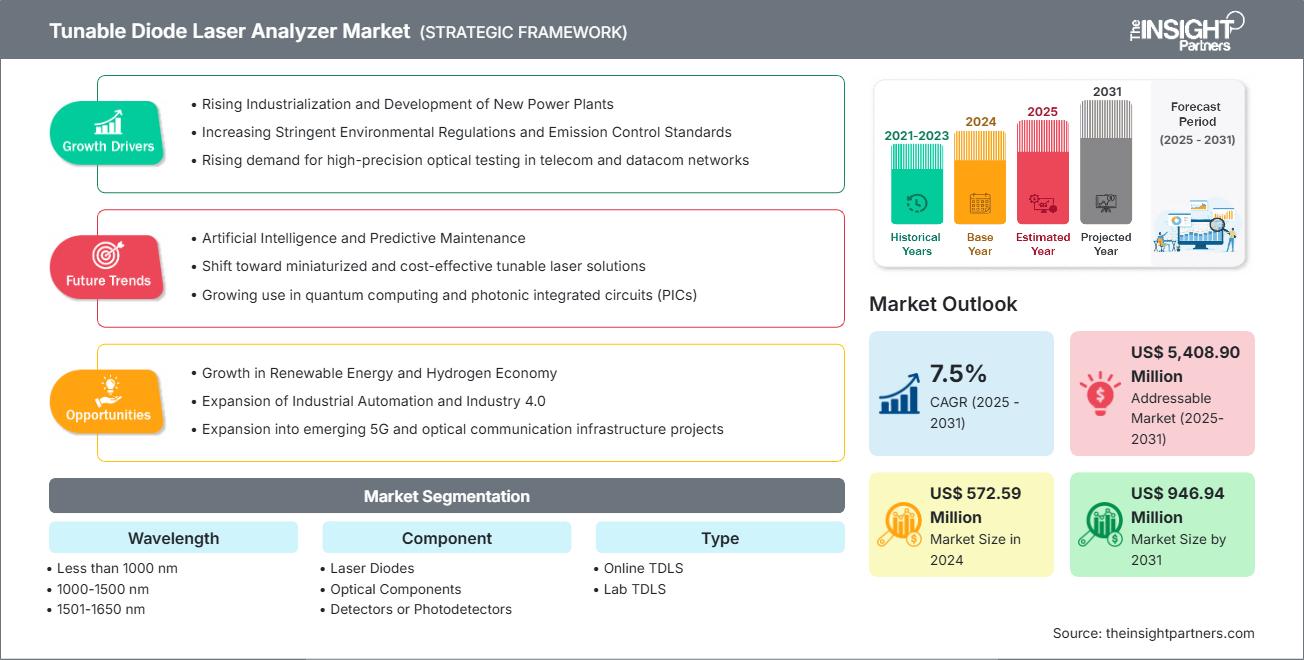
-
获取此报告的顶级关键市场趋势。此免费样品将包括数据分析,从市场趋势到估计和预测。
可调谐二极管激光分析仪市场驱动因素和机遇
市场驱动因素:
-
高速光通信需求不断增长
随着数据传输需求的快速扩展(尤其是由 5G 网络和数据中心推动),可调谐二极管激光分析仪对于测试和优化高速光学元件变得至关重要。 -
先进的光子学和光纤技术
光子集成电路和光纤的不断创新推动了对精确测试解决方案的需求,从而推动了可调谐二极管激光分析仪的采用。 -
扩展5G和物联网基础设施
5G 和物联网网络的部署需要对光学设备进行大量测试,其中可调谐激光二极管分析仪在确保信号完整性方面发挥着至关重要的作用。 -
电信和航空航天领域的研发不断增长
电信、航空航天和国防领域加强的研究和开发力度,增加了对支持技术验证和创新的高性能激光分析工具的需求。 -
光学元件小型化趋势
随着光学设备变得越来越小、越来越集成,需要可调谐激光二极管分析仪等精确的表征工具来保持性能和质量控制。
市场机会:
-
将人工智能和自动化融入光学测试
将人工智能和自动化融入光学测试系统为提高效率、减少错误和实现智能数据分析提供了重要机会。 -
扩展量子计算和传感的应用
量子技术的进步推动了对超精密光学测量工具的需求,为可调谐二极管激光分析仪创造了一个利基但快速增长的市场。 -
医疗和生物光子学应用的采用率不断提高
光学技术在医学成像、诊断和生物光子学领域的应用日益广泛,推动了对高精度、高可靠性分析仪器的需求。 -
开发模块化和可定制的解决方案
设计具有模块化功能和行业特定定制的可调谐二极管激光分析仪的能力(特别是对于航空航天、国防和制造业)为产品差异化和收入增长提供了新的途径。
可调谐二极管激光分析仪市场报告细分分析
可调谐二极管激光分析仪市场细分为不同的细分市场,以便更清晰地了解其运作方式、增长潜力和最新趋势。以下是大多数行业报告中使用的标准细分方法:
按类型:
-
在线TDLAS(可调谐二极管激光吸收光谱):
一种实时、现场气体分析方法,直接用于工业过程,连续监测气体浓度。 -
TDLAS实验室:
基于实验室的 TDLAS 系统用于在受控条件下进行精确的气体测量,通常用于研究、校准或产品测试。
按类别:
-
石油和天然气:
TDLA 系统用于实时监控上游、中游和下游作业中的气体排放、燃烧控制和安全合规性。 -
金属和采矿:
用于金属提取、冶炼和精炼过程中的过程控制和排放监测,以提高效率并减少环境影响。 -
能源和电力:
TDLA 能够精确测量发电厂中的气体,以优化燃烧并满足法规要求。 -
废物和水处理:
用于检测处理设施中的氨或甲烷等有害气体,确保安全高效的运行。 -
半导体和电子:
用于洁净室环境和制造过程的精确气体监测,以保持产品质量和安全标准
按波长:
- 小于1000纳米
- 1000-1500纳米
- 1501–1650 纳米
- 1651–2000纳米
- 大于2000纳米
按组件:
- 激光二极管
- 光学元件
- 探测器/光电探测器
- 光谱仪
- 校准设备
- 其他的
按地域划分:
- 北美
- 欧洲
- 亚太地区
- 中东和非洲
- 南美洲和中美洲
亚太地区可调谐二极管激光分析仪市场预计将出现最快的增长。吸烟人口不断增加,人们转向替代烟草。
可调谐二极管激光分析仪市场区域洞察
Insight Partners 的分析师已详尽阐述了预测期内影响可调谐二极管激光分析仪市场的区域趋势和因素。本节还讨论了可调谐二极管激光分析仪市场在北美、欧洲、亚太、中东和非洲以及南美和中美的细分市场和地域分布。
可调谐二极管激光分析仪市场报告范围
| 报告属性 | 细节 |
|---|---|
| 2024年的市场规模 | 5.7259亿美元 |
| 2031年的市场规模 | 9.4694亿美元 |
| 全球复合年增长率(2025-2031) | 7.5% |
| 史料 | 2021-2023 |
| 预测期 | 2025-2031 |
| 涵盖的领域 |
按波长
|
| 覆盖地区和国家 |
北美
|
| 市场领导者和主要公司简介 |
|
可调谐二极管激光分析仪市场参与者密度:了解其对业务动态的影响
可调谐二极管激光分析仪市场正在快速增长,这得益于终端用户需求的不断增长,而这些需求的驱动因素包括消费者偏好的演变、技术进步以及对产品优势的认知度的提升。随着需求的增长,企业正在扩展产品线,不断创新以满足消费者需求,并抓住新兴趋势,从而进一步推动市场增长。
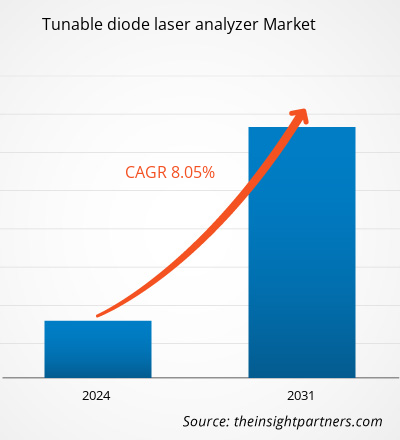
- 获取可调谐二极管激光分析仪市场主要参与者概览
可调谐二极管激光分析仪市场份额(按地区)分析
预计亚太地区将成为未来几年增长最快的地区。南美、中美、中东和非洲等新兴市场也为可调谐二极管激光分析仪供应商提供了许多尚未开发的扩张机会。
由于严格的环境法规、日益增长的工业自动化以及对精确快速气体检测的需求,可调谐二极管激光分析仪市场在各个地区的增长情况有所不同。以下是各地区的市场份额和趋势摘要:
1. 北美
-
市场份额:
由于早期采用该技术,占据了全球 TDLA 市场的很大份额。 -
关键驱动因素:
- 强力执行环境法规(例如EPA排放标准)
- 对石油天然气、发电和化学加工行业的高投资
- 拥有领先的 TDLA 制造商和高研发活动
-
趋势:
采用智能自动化气体监测系统,注重能源效率,并越来越多地用激光系统替代传统分析仪。
2.欧洲
-
市场份额:
在严格的欧盟排放标准和工业现代化的带动下,占据了相当大的份额。 -
关键驱动因素:
- 欧盟对空气质量和工业排放的严格指令
- 扩大可再生能源和废物能源项目
- 制造业和公用事业采用工业 4.0 标准
-
趋势:
水处理和发电厂中基于激光的分析的增长、与物联网平台的集成以及对低维护气体分析仪的需求。
3. 亚太地区
-
市场份额:
增长最快的区域市场,由工业增长和基础设施发展推动。 -
关键驱动因素:
- 制造业、采矿业和能源业的快速扩张
- 政府越来越重视污染监测(尤其是在中国和印度)
- 自动化和过程控制系统的采用率不断提高
-
趋势:
TDLA 在燃煤电厂排放监测中的应用激增,韩国和台湾的半导体产业不断扩大,政府支持产业升级。
4.南美洲和中美洲
-
市场份额:
具有中等增长潜力的新兴市场。 -
关键驱动因素:
- 扩大能源和发电活动,特别是在巴西和阿根廷
- 各工业领域对环境合规性的需求不断提高
- 采矿和金属加工领域的投资不断增加
-
趋势:
工业工厂逐渐转向数字气体分析,对低维护和坚固的 TDLA 系统产生兴趣,并区域性地采用清洁空气政策。
5.中东和非洲
-
市场份额:
稳步增长,主要受石油和天然气勘探以及炼油业务的推动。 -
关键驱动因素:
- 石油和石化设施工艺优化和安全的需求
- 恶劣环境下需要坚固的气体分析仪
- 工业活动逐渐多元化,不再局限于石油
-
趋势:
海湾合作委员会国家转向先进的气体检测系统,海水淡化厂和化肥制造厂越来越多地采用该系统,政府也开始主导清洁能源计划。
可调谐二极管激光分析仪市场参与者密度:了解其对业务动态的影响
市场密度高,竞争激烈
由于埃森哲公司、ACI Worldwide Inc、BAE Systems Plc、EastNets、Open Text Corp、甲骨文公司、纳斯达克公司、SAS Institute Inc、NICE Ltd、LexisNexis Risk Solutions Group、Assent Business Technology, Inc.、Ascent Technologies, Inc. 和 Fiserv Inc. 等老牌企业的存在,竞争十分激烈,它们正在为不同地区的竞争格局做出贡献。
这种激烈的竞争促使公司通过提供以下产品脱颖而出:
- 创新产品设计,包括模块化和可充电设备
- 多种口味和尼古丁浓度,满足不同消费者的喜好
- 与移动应用程序集成,用于使用情况跟踪、定制和安全警报
- 可持续且环保的选择,例如可回收或可生物降解的组件
机遇与战略举措
- 通过线上和线下零售渠道扩大分销网络,提升市场覆盖率
- 投资研发下一代电子烟技术,包括智能设备和以健康为中心的替代品
- 通过价格实惠的产品线和本地化的营销活动瞄准新兴市场
- 与卫生机构合作,将可调谐二极管激光分析仪定位为烟草减害计划的一部分
可调谐二极管激光分析仪市场的主要公司有:
- 艾默生电气公司(美国)
- 西门子股份公司(德国)
- ABB有限公司(瑞士)
- 梅特勒-托利多国际公司(美国)
- TELEDYNE分析仪器(美国)
- 横河电机株式会社(日本)
- NEO Monitors AS(挪威)
- 仕富梅集团有限公司(英国)
- Sick AG(德国)
- AMETEK Inc.(美国)
免责声明:以上列出的公司没有按照任何特定顺序排列。
研究过程中分析的其他公司:
- ABB有限公司
- 艾默生电气公司
- 通用电气(GE)
- 梅特勒托利多国际公司
- SICK 股份公司/SICK 公司
- 西门子股份公司
- 横河电机株式会社
- 仕富梅集团有限公司
- Norsk Elektro Optikk(NEO 监视器)
- 阿美特克公司
- 光谱传感器(Endress+Hauser)
- Endress+Hauser集团
- ABB 测量与分析(与 ABB 相同)
- 霍尼韦尔国际公司
- 富士电机株式会社
- Teledyne Technologies(分析仪器)
- 赛默飞世尔科技公司
- 堀场制作所
- MKS仪器公司
- 布鲁克公司
- 奥普西斯公司
- LumaSense技术公司
- 聚焦光子学公司
- TOPTICA Photonics AG
- 贝克休斯(Panametrics)
- Spectris plc(仕富梅的母公司)
- 东宇光电子
- 阿科玛
- 伯索尔德技术公司
- CILAS(法国)
可调谐二极管激光分析仪市场新闻和最新发展
-
艾默生宣布推出 Rosemount™ 470XA 气相色谱仪
艾默生宣布推出 Rosemount™ 470XA 气相色谱仪,旨在简化贸易交接和其他过程应用中的天然气分析。Rosemount 470XA 的分析仪设计基于功能多样、久经行业验证的 Rosemount™ 770XA 气相色谱仪,以满足这些及其他需求。Rosemount 770XA 以其坚固耐用和应用广泛而闻名。这为该领域的产品开辟了更广泛的应用场景,例如碳捕获、利用和储存、可再生天然气以及定制应用。
-
Teledyne Analytical Instruments 推出 RS 系列,这是在线氧气和热导率分析领域的最新创新
Teledyne Analytical Instruments 推出了 RS 系列——其在线氧气和热导率分析领域的最新进展。RS 系列旨在重新定义精度和易用性的标准,提供卓越的性能、现代化的功能以及专为当代工业应用量身定制的流线型设计。这些新一代分析仪比之前的型号具有更高的精度、灵敏度和准确度。RS 系列采用先进的电子设备和升级的图形用户界面,确保直观的操作和无缝的用户交互,所有这些都集成在紧凑而优雅的机箱中。
可调谐二极管激光分析仪市场报告覆盖范围和交付成果
《可调谐二极管激光分析仪市场规模和预测(2021-2031)》报告对以下领域进行了详细的市场分析:
- 可调谐二极管激光分析仪市场规模以及涵盖范围内所有关键细分市场的全球、区域和国家层面的预测
- 可调谐二极管激光分析仪市场趋势以及市场动态,如驱动因素、限制因素和关键机遇
- 详细的 PEST 和 SWOT 分析
- 可调谐二极管激光分析仪市场分析涵盖主要市场趋势、全球和区域框架、主要参与者、法规和最新市场发展
- 行业格局和竞争分析,涵盖市场集中度、热图分析、知名参与者以及可调谐二极管激光分析仪市场的最新发展
- 详细的公司简介
- 历史分析(2 年)、基准年、预测(7 年)及复合年增长率
- PEST和SWOT分析
- 市场规模、价值/数量 - 全球、区域、国家
- 行业和竞争格局
- Excel 数据集
近期报告
相关报告
客户评价
购买理由
- 明智的决策
- 了解市场动态
- 竞争分析
- 客户洞察
- 市场预测
- 风险规避
- 战略规划
- 投资论证
- 识别新兴市场
- 优化营销策略
- 提升运营效率
- 顺应监管趋势












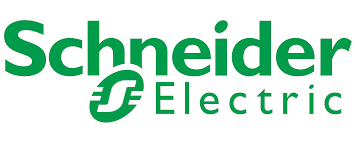


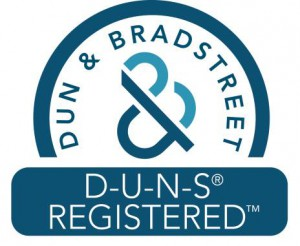
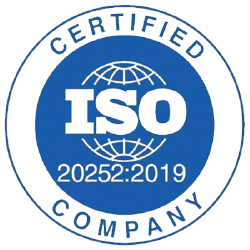





 获取免费样品 - 可调谐二极管激光分析仪市场
获取免费样品 - 可调谐二极管激光分析仪市场